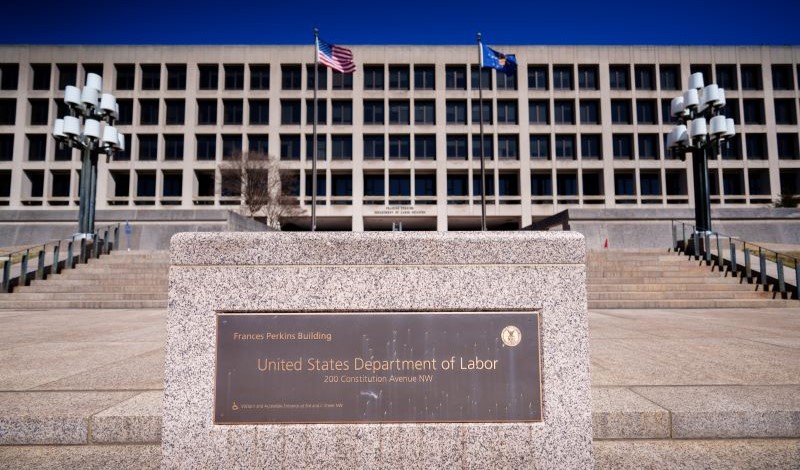
A proposed rule that rolls back protections for workers sends a troubling signal about regulatory reforms.
July was a busy month at the U.S. Department of Labor. Within a period of a few days, the agency announced dozens of regulatory changes, primarily intended to roll back existing protections for workers. Although some of these changes, such as a proposal to eliminate minimum wage and overtime pay requirements for home care workers, garnered media attention, others fell more under the radar.
One lesser-noticed, but potentially significant, regulatory announcement came out of the Occupational Safety and Health Administration (OSHA). The agency announced a proposed rule that relates to the Occupational Safety and Health Act—known as the OSH Act—and its “general duty clause,” which obligates employers to keep workers safe from known hazards when there is no specifically applicable OSHA safety standard. The general duty clause is, essentially, the safety net for worker safety, ensuring that employers have some basic obligation to take commonsense steps to protect workers from known and preventable dangers.
The new proposal would create an exemption from the general duty clause’s protections for workers engaged in “inherently risky employment activities,” if their employer determines that hazardous conditions cannot be eliminated without fundamentally altering the activity. In a nutshell, if the rule were issued, employers would have no general legal obligation to furnish workers in such occupations with a workplace that is “free from recognized hazards that are causing or are likely to cause death or serious physical harm.”
The proposal depicts this new safety exemption as narrow in focus, targeting only the entertainment and sports industries, but the draft opens the door for a broader reading. Moreover, the implications of carving even narrow classifications of workers and occupations out of the general duty clause could be far more significant than the Labor Department’s “nothing to see here” approach would suggest.
The rule’s justification also raises cause for alarm. The proposal invokes recent U.S. Supreme Court cases addressing the “major questions doctrine,” where the Court has held that agencies lack authority to regulate on matters of “economic and political significance” without clear congressional authorization. The proposed rule suggests that these decisions somehow compel the Labor Department to revisit the scope of the OSH Act because a hypothetical future agency could pursue enforcement in a manner that would implicate “policy-sensitive judgments.” Although this flimsy rationale does not hold up to scrutiny, it suggests that executive agencies such as the Labor Department are taking full advantage of the “major questions doctrine” as a fig leaf to rationalize rollbacks of public protections that have no real policy justification.
As noted above, the general duty clause refers to the provision of the OSH Act requiring that each employer “shall furnish to each of his employees employment and a place of employment which are free from recognized hazards that are causing or are likely to cause death or serious physical harm to his employees.” The clause has been invoked since the Act’s inception to protect workers from dangerous conditions that the agency has not specifically addressed through a safety standard.
To establish a violation, OSHA must prove four things: The employer failed to keep the workplace free of a hazard to which its employees were exposed, the hazard was recognized, the hazard was causing or likely to cause death or serious physical harm, and a feasible and practical method to correct the risk was available.
The Labor Department’s interest in revisiting the scope of the general duty clause harkens back to an agency enforcement action arising out of events more than 15 years ago, when a trainer at the SeaWorld theme park died after being attacked by an orca that had a history of dangerous interactions with trainers. OSHA issued a citation to SeaWorld under the general duty clause for exposing trainers to a recognized hazard. SeaWorld challenged the citation, arguing, among other things, that a risk cannot constitute a “recognized hazard” for purposes of the general duty clause when the work involved is inherently dangerous.
The U.S. Court of Appeals for the D.C. Circuit upheld the agency’s actions in Seaworld v. Perez. The majority specifically rejected SeaWorld’s argument that the general duty clause should not apply to workers in dangerous occupations because they “accepted and controlled” the risk of their work, explaining that this “assumption of risk” argument was contrary to the U.S. Congress’s clear direction in the OSH Act.
Then-Judge Brett Kavanaugh wrote an emphatic dissent from the decision, denouncing OSHA for overreaching and accusing the agency of inconsistency in asserting its authority to apply the general duty clause. But although framed in principles of administrative law, Judge Kavanaugh’s dissent makes clear that his disagreement with the majority was grounded in a more fundamental policy view. He argued that it is “paternalistic” for the government to require employers to take safety precautions when workers are voluntarily choosing to pursue potentially dangerous athletic or entertainment pursuits.
The Labor Department’s proposed rule on inherently risky activities makes no secret of the fact that its goal is to reverse the outcome of the SeaWorld case and codify Kavanaugh’s dissenting position into law. The proposed rule quotes extensively from the dissent’s reasoning and states that the Labor Department “now preliminarily concurs with the dissent’s concerns,” elevating one judge’s dissenting views as if they compelled the agency to revisit policy.
As a former OSHA official has observed, the Labor Department’s motivation to pursue this particular rule at this particular time is difficult to discern. Excessive interference with sports and entertainment events by OSHA has hardly been a rampant problem plaguing the country. The Department’s decision to expend agency resources and political capital on the rule is particularly mystifying in light of the Trump Administration’s executive order demanding that agencies eliminate 10 existing regulations for each new regulation issued. It is hard to imagine that it would be a worthwhile endeavor for OSHA to eliminate 10 workplace safety regulations to enshrine Justice Kavanaugh’s views on paternalism into the Code of Federal Regulations.
To be sure, there is some language in the Labor Department’s proposed rule suggesting that the new carveout from the general duty clause is intended to be narrow in scope. The proposed rule language provides a list of sectors to which the exemption would apply, including live entertainment, animal handling, and professional sports. The rule language, however, notes that this is a “non-exhaustive list”—meaning that, if the language is finalized as written, the Labor Department would be free to apply the exemption to other sectors of the economy.
The rule also asks for comment on “which professional and performance-based occupations perform inherently risky activities” and whether there are “any other potential industry sectors or occupations to which the proposed provision may apply.” Not surprisingly, representatives of regulated industries are already jumping on these invitations in the proposed rule, urging clients to comment and suggest broadening the rule’s scope to additional industries and occupations. So, there is ample reason to fear that the proposal will open the door to a far broader watering down of the general duty clause.
If the Labor Department takes the regulated industry up on its suggestions, it is easy to see how the implicit “assumption of risk” rationale that underlies both the proposed rule and Judge Kavanaugh’s SeaWorld dissent could be extended to a variety of other occupations. Indeed, the SeaWorld majority made just this point, noting that “many traditional industries can be extremely dangerous to their employees: construction, metal pouring, logging, welding, firefighting, roofing, electrical power line installation, handling explosives.” These jobs all involve some level of risk, but most reasonable minds would agree that such risks speak to the need for more—not fewer—workplace safety protections.
Weakening the general duty clause is a clear threat to worker safety. Although more obscure than other recent hot-button workplace health and safety issues, such as extreme heat or infectious disease transmission, the general duty clause is a foundational part of our worker safety system. It provides a baseline rule that employers have to protect their workers from known and preventable hazards, even when there is no specific OSHA standard dictating a particular safety protocol.
Because the OSHA standard-setting process is notoriously long and arduous, the general duty clause is an invaluable gap-filler that has been used to address critical safety issues. Carving workers or occupations from the general duty clause has serious implications. In the absence of any specific OSHA standard, many workers would have no workplace safety protections at all, even from hazards that their employer is capable of preventing.
In addition to potentially undermining workplace safety and health, the proposal sends a troubling signal about how executive agencies such as the Labor Department may be using the major questions doctrine to pursue regulatory reforms that lack adequate policy-based justification.
As noted above, the major questions doctrine is a canon of judicial interpretation suggesting that, when faced with a statutory ambiguity, courts should reject an agency’s claim of authority to decide a question of major economic and political significance in the absence of clear authorizing language in the statute. The Supreme Court has invoked this doctrine in cases involving agency efforts to regulate major national issues, such as the U.S. Food and Drug Administration’s authority to regulate the tobacco industry or the U.S. Attorney General’s regulation of assisted-suicide drugs. Indeed, the Court previously used this doctrine to invalidate OSHA’s efforts to enact an emergency temporary standard imposing COVID-19 vaccination and testing requirements on approximately 80 million workers nationwide.
In April of this year, President Donald J. Trump issued an executive memorandum instructing federal agencies to review all existing regulations for consistency with a list of specified Supreme Court decisions and repeal—without notice-and-comment—any rule the agency deems inconsistent with the Court’s decisions. The memorandum referenced West Virginia v. EPA, a leading major questions doctrine case, sending a clear signal to agencies that they are empowered to repeal existing rules even in the absence of any policy-related concerns with the rule’s implementation, change in circumstances, or adverse judicial precedent. Instead, agencies are now free to revisit even longstanding and judicially upheld regulations simply because the new agency leadership believes the regulation deals with a matter of national significance.
This directive has the potential to disrupt long-settled regulatory schemes that protect the public health and welfare. Commentators have noted, however, that efforts to roll back regulations based on this rationale may be of questionable legality.
The Labor Department’s invocation of this doctrine in its proposed rule speaks to an even more far-reaching potential abuse of the major questions doctrine. Here, the agency is not using the doctrine to justify revisiting a prior regulation that is currently on the books and being enforced, but instead, to justify a new regulation aimed at preventing some hypothetical future agency prosecution that might be based on an interpretation of the statute that current agency officials believe could implicate issues of national concern.
Setting aside the dubiousness of the Labor Department’s hyperbolic assertion that application of the general duty clause to a sports or entertainment business would be a “policy-sensitive” judgment with “far-reaching consequences for culture, commerce, and individual liberty,” the frailty of the agency’s rationale for proceeding is noteworthy. The Labor Department has decided to issue an entirely new rule, weakening a longstanding agency interpretation of one of its core statutory provisions based on a concern that it was once, in an enforcement action 15 years ago, applied in a manner that current agency leadership thinks implicated significant questions of policy. The Department has done so even though the D.C. Circuit rejected that argument, and the agency has full authority—without any regulatory change—to exercise its prosecutorial discretion and not pursue enforcement actions it disagrees with.
The implications if other agencies were to follow in the Labor Department’s footsteps are alarming. The use of a simple citation to West Virginia v. EPA to justify a new regulation preemptively restricting the agency’s enforcement authority and tying the hands of a future administration, regardless of the facts on the ground or the relevant policy considerations, hardly meets the standard of reasoned decision-making that the Administrative Procedure Act requires.
There are certainly significant questions about the lawfulness of the proposal itself, and it may be vulnerable to legal challenge. For instance, former OSHA deputy assistant secretary Jordan Barab has argued that OSHA does not have the authority to scale back the scope of the general duty clause. Barab has also noted that the agency did not consider the cost of worker injury or deaths in its cost-benefit analysis.
Regardless of the fate of this particular rule, two lessons are clear from the trajectory of the Labor Department’s actions that should sound alarm bells for the next four years: This Labor Department is no friend of vulnerable workers, and the Department clearly intends to take full advantage of the White House’s directive that agencies should use whatever means necessary to roll back critical regulatory protections for working people.




